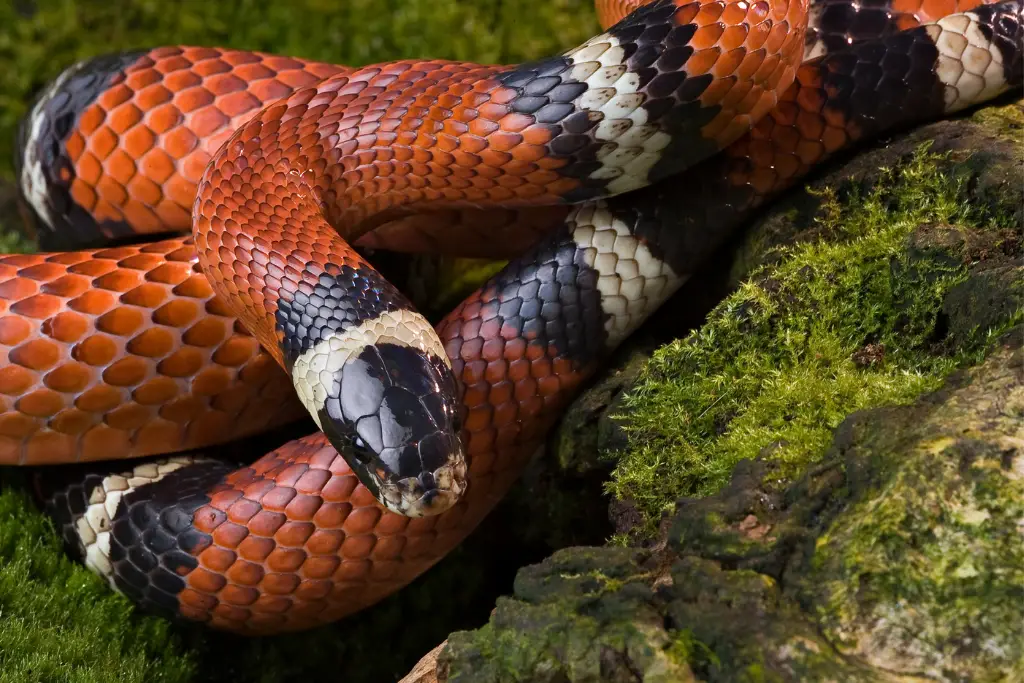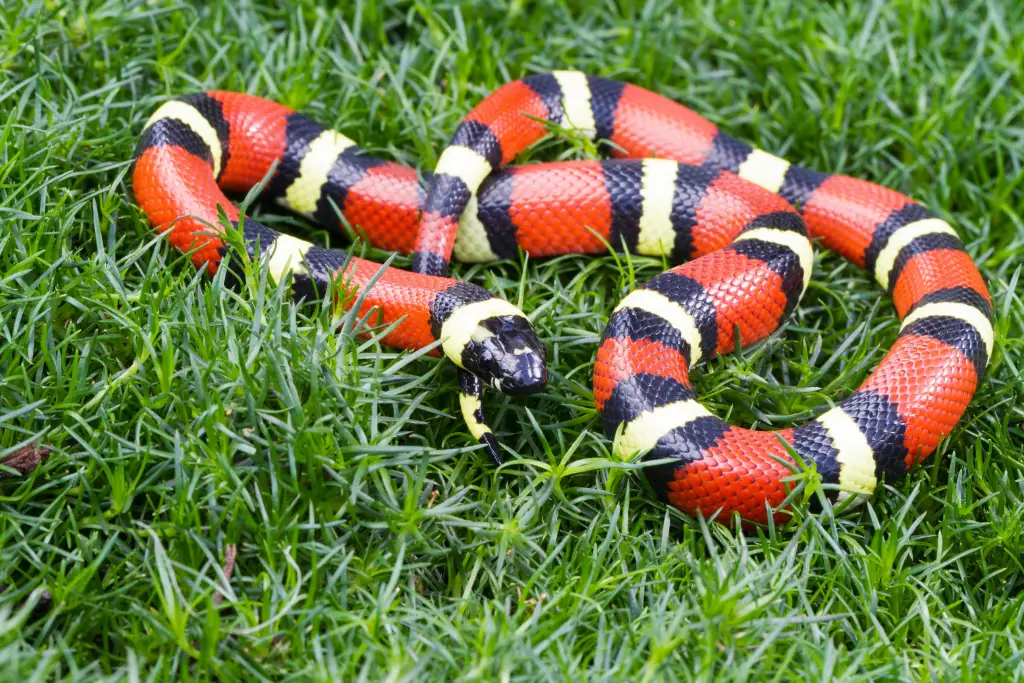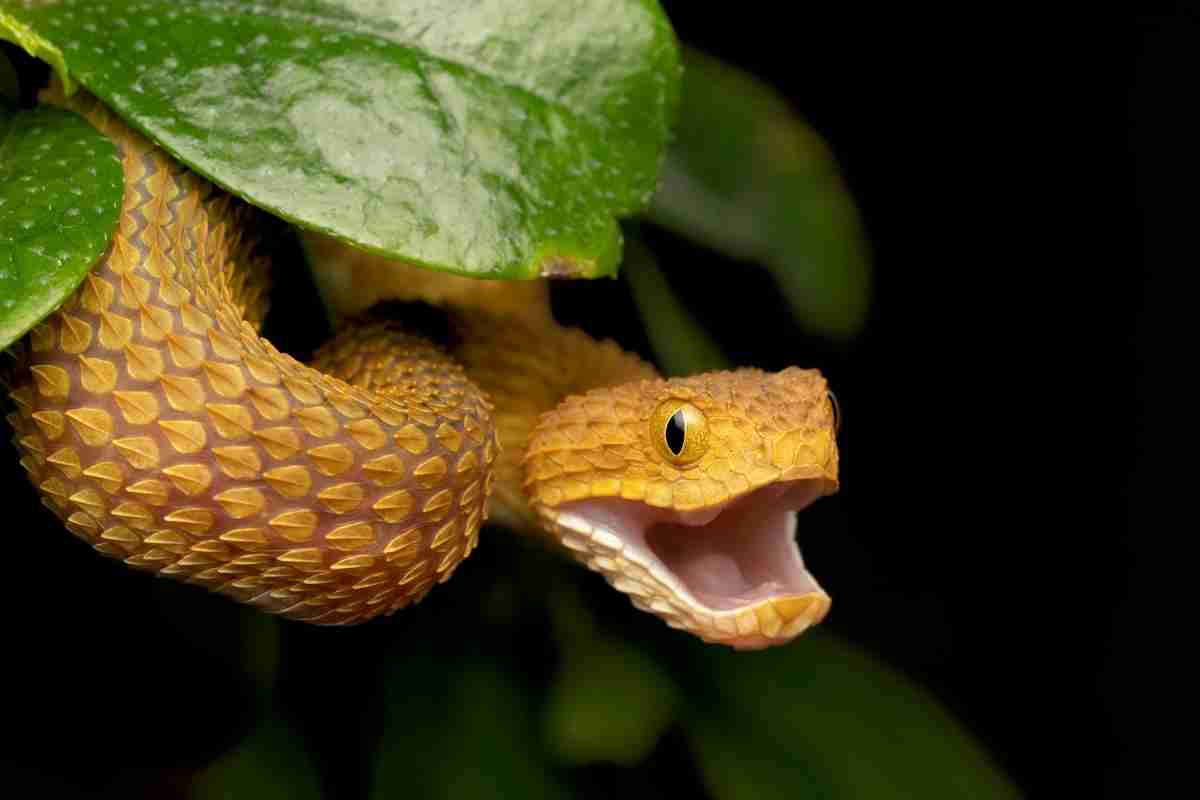It is not often that you hear about milk snakes, but they are actually quite common. Milk snakes are often confused with venomous coral snakes or copperheads because they share similar colors and patterns.
But what if you stumble across a milk snake in the wild and it strikes? The first thing you want to know is are these snakes venomous?
Well, the good news is No! Milk Snakes are not venomous, they are constrictors. Milk Snakes squeeze their prey to death rather than injecting them with any sort of toxin that would kill them quickly.
Many people think that just because a snake has fangs and delivers its prey via injection means it must be venomous, but this simply isn’t true.
Poisonous Vs Venomous
Whether they are poisonous or venomous both are considered very dangerous so it’s important to note the difference between them so you don’t get confused from one for another!
So what is the difference between Poisonous and Venomous snakes?
- A poisonous snake is one that has toxins in its body. The toxin can be in the form of venom or poison glands that secrete a noxious substance when they bite someone.
- A venomous snake injects you with some sort of neurotoxin, hemotoxin, cytotoxin, or many other types of poisons through their fangs to cause harm and even death if untreated.
Either way, both can be very dangerous so it’s important to know what you are dealing with!
There are plenty of nonvenomous snakes that can strike and kill their prey through other means. Which now brings us to the question are milk snakes poisonous?
Are Milk Snakes Poisonous?
No! milk snakes are not poisonous nor do they pose a threat to humans. These snakes are usually docile around people and will only strike if they feel threatened.
If you do happen to encounter a milk snake in the wild there is no need for concern, these snakes pose little threat unless provoked.
If a milk snake was to bite you the worse that could happen is a slight swelling or itching. With that said you should still seek medical attention if you are bitten by a milk snake.
They will typically inhabit rock walls, barns, and even homes where they hunt rodents such as mice and rats for food. Milk Snakes use their bright colors to warn predators.
Related Article:
Mexican Milk Snakes
Mexican milk snakes are not poisonous and like your average milk snake, they are constrictors. They are typically found in the southern parts of Texas and Mexico and are usually dark brown with a yellowish or reddish stripe down their backs.
Again, these snakes will only bite if provoked so there should never be any reason for you to handle one of them unless you’re doing some sort of research on them.
If caught you can expect the milksnake’s reaction to being that of aggression!
Pueblan Milk Snakes
Pueblan Milk Snakes are a beautiful breed of snake that have been known to inhabit regions from Mexico all the way up through Texas.
They can be found in both dry and humid climates which is common for many types of snakes because they like to adapt well to their surroundings.
Although they are not Poisonous if you happen across one it’s best not to mess around or try and handle them! this will only agitate the animal causing it to stress which could lead to them taking a strict at you.
If these milk snakes bite again it shouldn’t pose any harm. Just Remember to be on the safe side and seek medical attention if you are bitten by one.
Nelson Milk Snakes
Although the Nelson milk snake may look intimidating it is still a nonvenomous snake. these snakes are great at hunting down and killing fish which isn’t something that many types of constrictors can do.
Nelson milk snakes have been found in Canada so if you happen to come across one there’s no need for concern unless your dog runs into it or tries to attack.
Once again this will only be an issue if you bring them within close proximity with each other.

Honduran Milk Snakes
Honduran milk snakes are not poisonous, however, they do have a bad reputation of being extremely aggressive which will cause them to strike at you if feeling threatened or cornered.
They can grow up to be about thirty-five inches long and they typically inhabit rainforests in the Honduras regions. Honduran milk snake diet consists mainly of rodents.
Sinaloan Milk Snakes
Sinaloan milk snakes are not poisonous and do not pose any threat to humans they can be found in many different habitats and they tend to adapt well to their surroundings.
However, like all milk snakes if you see one you should try to keep your distance and let it go on its way.
Sinaloan milk snakes are one of the larger species of milk snake so if you happen across a large group of these reptiles they can be startling but don’t panic because there is no need for concern as long as you give them their space and leave them alone.
Are Milk Snakes Poisonous To Dogs?
No, milk snakes are not poisonous to dogs, however, they can still cause harm to your pet. Because dogs usually sniff the ground they can be vulnerable to a snake bite.
For example, if the milk snake was to strike and bite your dog in the eyes or nose then this can cause incredible pain for your pooch or worth if they do get bitten in the eye it could cause permanent damage.
If you happen across a milk snake in your home with your dog then do not panic! The best thing that you can do is keep both of them calm by minimizing their exposure to one another.
You want to make sure that there isn’t any chance for either party getting hurt or attacked further because of how this could escalate the situation quickly turning deadly pretty fast.
What About Cats?
No, milk snakes are not poisonous to cats. But because the cat is small enough the milk snakes could constrict it and potentially kill the cat.
If you own a cat and you spot a milk snake or any other snake for that matter for should contact a professional snake removal company to come remove it safely.
In the means, it is wise to keep your cat indoors when you are not around or at least make sure that they cannot get into an area where a milk snake might be present.
Identifying A Milk Snake
The milk snake is a relatively harmless snake that’s common in the United States. If you have found one of these snakes around your property or are just curious about what it is, then hopefully this should help you identify if it’s a milk snake!
- Yellow And Light Brown Color
- Round Eyes With Black Pupils
- Hourglass Shape Pattern
- Between 3-4 Feet Long
Milk snakes can be identified by their color, pattern, and eyes. They are usually between 3-4 feet long, and have smooth scales, and can be bright yellow to light brownish in color similar to the copperhead snake.
The back has an hourglass shape pattern on it which is where they get the name milk snake from because of its resemblance to old-style milk bottles with similar patterns.
The most distinctive feature of this type of snake would definitely be its eyes since they are very unique in comparison to other species of reptiles out there!
Their pupils are shaped like slits instead of round circles like many others so don’t make the mistake of thinking all reptile eyes look. Milk snake’s eyes are round with black pupils.
These reptiles typically live in forested areas and can be found hiding under rocks or logs during daylight hours when they’re most active at night time.
They like to make their homes in decaying trees where there is plenty of vegetation for them to hide out in but they also do well living within human dwellings as long as it’s not too dry.
They eat mice, lizards, birds, eggs…other types of milk snakes!
So it’s important to note that no matter what kind of milk snake you may come across that it is extremely important to leave them alone and give them their space.
Conclusion
So now you know Milk snakes are not poisonous. but as before if you come across one it’s best not to handle them just in case it turns out to be a copperhead snake!
Many people have made the mistake of thinking it is a milk snake when it turns out to be a copperhead. Copperheads are extremely deadly and if you’re bitten by one of them you will need immediate medical assistance.




